While orioles are known for their striking appearance, there are several other bird species that may be mistaken for orioles at first glance. From similar bright colors to similar body shapes, these birds can be easily confused with orioles; especially for novice birdwatchers. However, a closer look at their physical features, habitat preferences, and behaviors can help to distinguish these birds from their oriole doppelgängers. Join us on a flight of fancy as we discuss 11 birds that look like orioles and how to spot the difference!

The orchard oriole is widely distributed throughout the Eastern and Central
United States
.
©John L. Absher/Shutterstock.com
What is an Oriole?
Orioles are medium-sized birds with a slender build and a long, pointed bill that is adapted for probing flowers and fruits for food. They are recognized by their bright plumage, which often includes vivid shades of yellow, orange, and black. Females and immature birds often have a more muted plumage, with yellow or greenish-yellow underparts and olive-green backs. Orioles have a distinctive, fluid flight pattern, with undulating wingbeats and occasional glides. Many species have a distinctive musical song, which is used by males to attract mates and defend territories. Orioles are generally arboreal, meaning that they spend most of their time in trees. They are found in a variety of habitats, from woodlands and forests to scrublands, parks, and gardens.
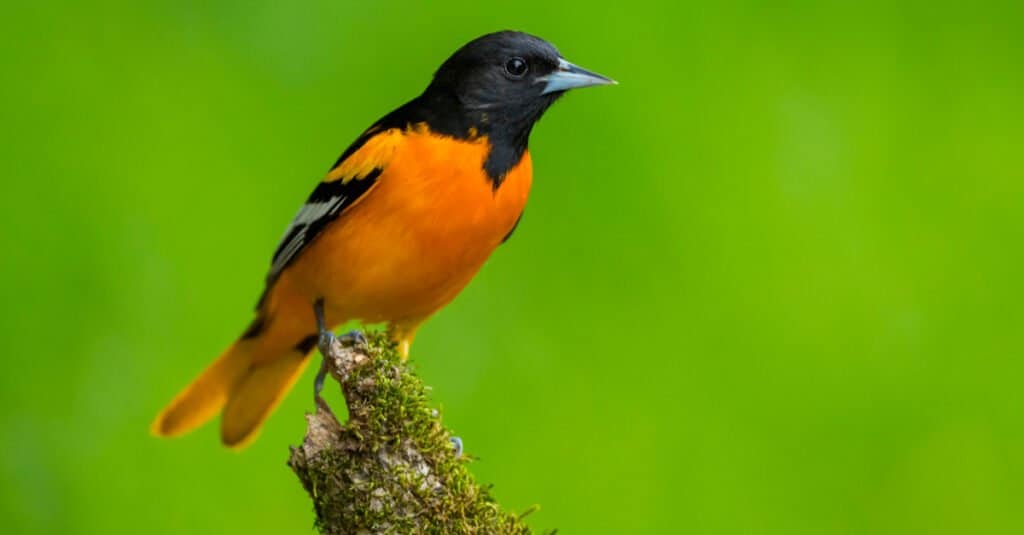
Orioles, like this Baltimore oriole, are recognized by their bright plumage, which often includes vivid shades of yellow, orange, and black.
©Agami Photo Agency/Shutterstock.com
There are two genera of orioles. There are approximately 29 species of Old World orioles in the genus Oriolus. Two of the most common species in this group include the Eurasian Golden Oriole (Oriolus oriolus) and the African Black-headed Oriole (Oriolus larvatus). There are around 28 species of New World orioles in the genus Icterus. There are nine species of New World orioles in North America. Two of the most widely distributed species in this group include the Baltimore Oriole (Icterus galbula) and the Orchard Oriole (Icterus spurius). Most orioles measure 6-8 inches (15-20 cm) in length with a wingspan of 9-12 inches (23-30 cm).

Though the female Eurasian Golden Oriole isn’t terribly colorful, the male is bright yellow with black markings.
©iStock.com/phototrip
11 Birds That Look Like Orioles

Not to be confused with actual orioles, the following birds look very similar. Take a look at their unique features.
Barn Swallow
The barn swallow (Hirundo rustica) is a beautiful bird. Barn swallows have a streamlined body shape with a slightly forked tail. They are about the same size as an oriole 6-8 inches (15-20 cm) in length but with a slightly larger wingspan of 11-14 inches (30-35 cm). They have a glossy, blue-black head and back, with a rusty-orange throat, forehead, and underparts.
The tail feathers are long and pointed, and the wings are long and pointed with a distinctive blue sheen on the upper surface. Barn swallows are agile and acrobatic fliers, with a fast, fluttery wingbeat and a swooping, diving flight pattern. They are able to catch insects on the wing and are often seen flying low over fields, pastures, and bodies of water in search of prey. As their name suggests, barn swallows are often found nesting in and around barns, sheds, and other man-made structures. They also nest under bridges and other overhangs, as well as in caves and cliffs.
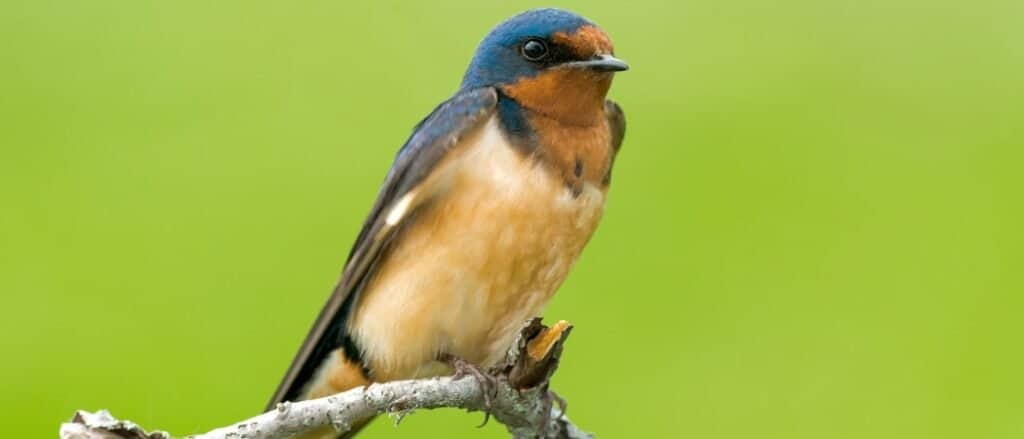
Barn swallows have a glossy, blue-black head and back, with a rusty-orange throat, forehead, and underparts.
©Paul Reeves Photography/Shutterstock.com
Eastern/Western Meadowlark
The Eastern meadowlark (Sturnella magna) and Western meadowlark (Sturnella neglecta) are two closely related bird species belonging to the family Icteridae that are often and easily mistaken for orioles. The Eastern meadowlark is found in the Eastern part of North America, while the Western meadowlark is found in the Western part of North America. The two species have overlapping ranges in the central United States. The Eastern meadowlark is often found in grasslands, fields, and meadows, while the Western meadowlark prefers drier habitats such as prairies, shrublands, and open woodlands
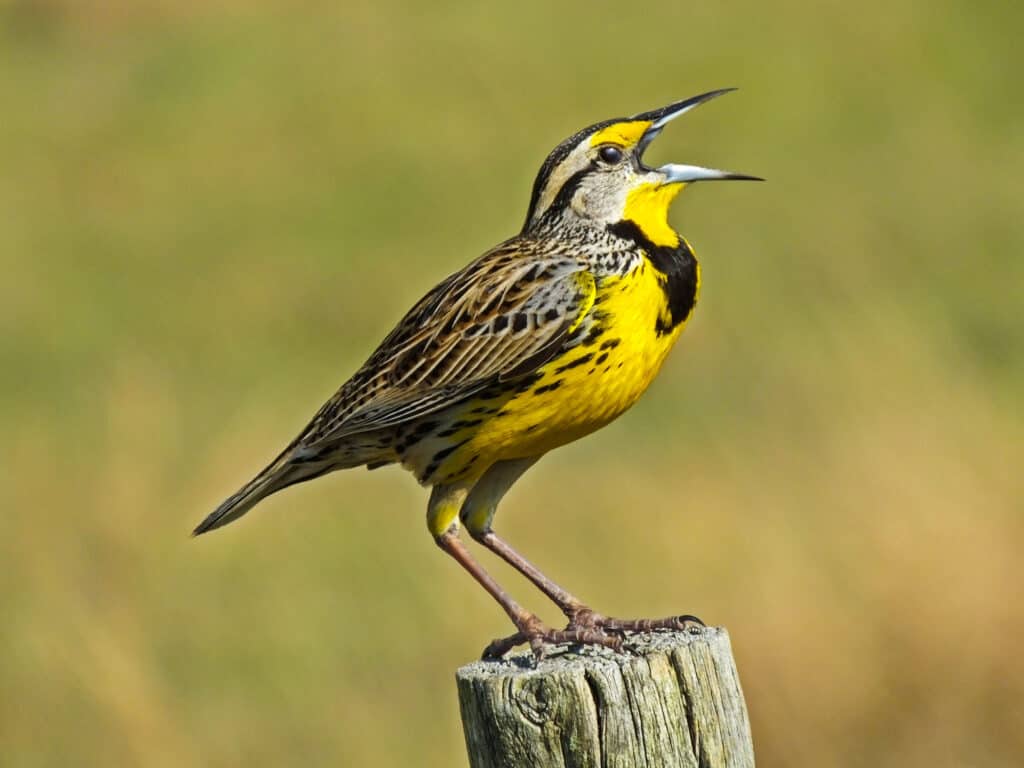
The Eastern meadowlark is often found in grasslands, fields, and meadows.
©iStock.com/passion4nature
Both the Eastern meadowlark and the Western meadowlark have bright yellow breasts with a distinctive black V shape on the chest, though the Eastern meadowlark tends to be a little darker. The two species also have slightly different songs and calls. Both species forage on the ground for insects and seeds and build nests on the ground. Meadowlarks are 7.5 to 11.0 inches (19 to 28 cm) long, with wingspans of 14-16 inches (35–40 cm).
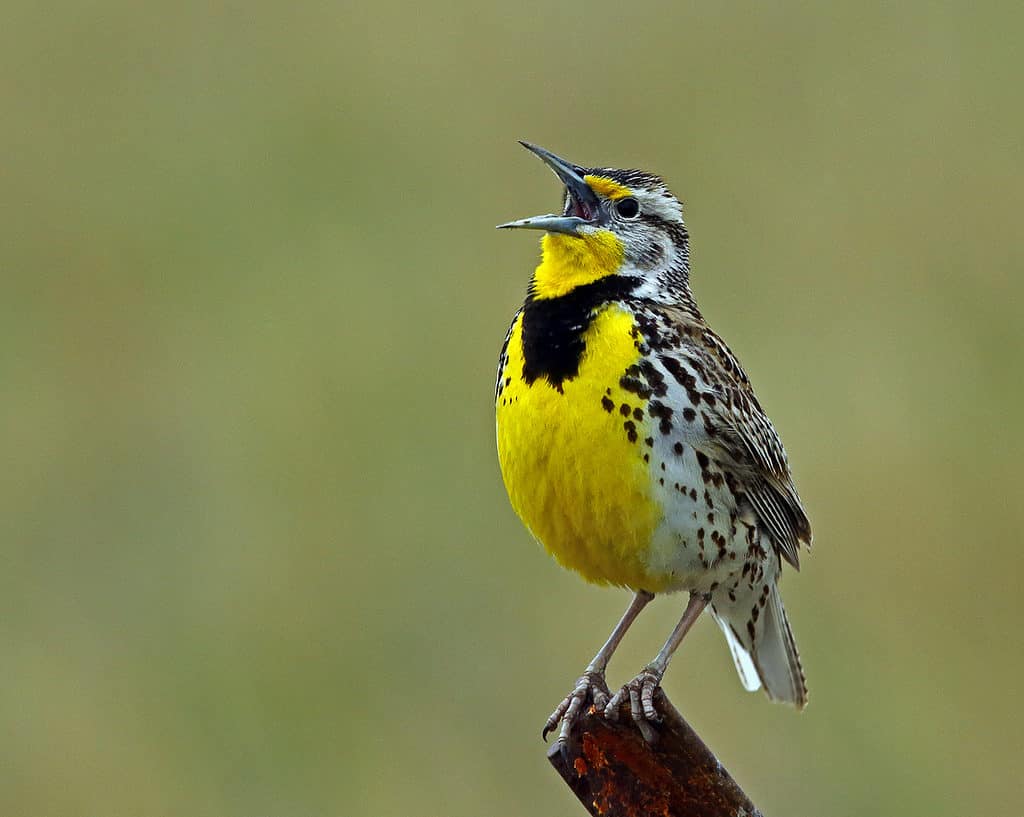
Both the Eastern meadowlark and the Western meadowlark, pictured, have a bright yellow breast with a distinctive black V shape on the chest.
©iStock.com/photographybyJHWilliams
Western Tanager
The Western tanager (Piranga ludoviciana) is a brightly colored bird that is native to Western North America. The Western tanager is a medium-sized bird, measuring about 6.5-7.5 inches (15-20 cm) in length, with a wingspan of 11.5 in (29 cm). It has a plump, round body with a short tail and a relatively large, thick beak. The male Western tanager is bright orange and yellow plumage on its head, neck, and upper breast, contrasting with its black back and wings. It also has bold, contrasting wing bars. The male’s belly is bright yellow.
In contrast, the female Western tanager has more subdued coloring, with an olive-green back and wings, yellow underparts, and a grayish head. Western tanagers are typically found in coniferous forests and woodlands, especially those with open canopies and a mixture of trees and shrubs. They are generally shy and solitary birds that spend much of their time foraging in the upper branches of trees. They feed mainly on insects and fruits.

Male western Tanagers are bright yellow with black wings and an orangish-red head.
©iStock.com/mtnmichelle
Towhees
Eastern Towhee
The Eastern towhee (Pipilo erythrophthalmus) is a medium-sized bird that is found in the Eastern and Central parts of North America, from Southern Canada to the Gulf of Mexico. It measures 8.3-9.8 inches (21–25 cm) in length, with a wingspan of up to 11 inches (27) cm. It has a distinctive black hood and throat, with rufous sides and white underparts, and red eyes. The Eastern towhee prefers to forage on the ground, where it feeds on seeds, insects, and fruits.

The Eastern towhee has a distinctive black hood and throat, with rufous sides and white underparts, and red eyes.
©John L. Absher/Shutterstock.com
Spotted Towhee
The spotted towhee is a bird that is found in the Western part of North America, from Alaska to Mexico. It has a black hood and back, with rufous sides and white underparts. The spotted towhee is similar in size and appearance to the Eastern towhee, except for the white spots on its wings and back. The spotted towhee also prefers to forage on the ground, where it feeds on seeds, insects, and fruits.

The Spotted towhee also prefers to forage on the ground, where it feeds on seeds, insects, and fruits.
©iStock.com/jamesvancouver
American Robin
The American robin (Turdus migratorius) is a migratory bird species that is widespread throughout North America. It is a medium-sized bird, measuring about 9-11 inches (22-27 cm) long with a wingspan of around 12-16 inches (30-40 cm). It has a plump, round body with a relatively long tail and a slender, straight bill.
The American robin has a dark gray or brown back and wings, a reddish-orange breast, and belly. Its head is black with a white eye ring and a yellow bill. The female robin has a similar coloring to the male, but her plumage is slightly duller. American robins are found in a wide range of habitats, including woodlands, forests, parks, and gardens. They are also known to frequent suburban and urban areas.
Robins are active, social birds that are often seen hopping or running across lawns and fields in search of food. They are known for their melodious, flute-like song, which they use to establish territories and attract mates. American robins primarily feed on insects, earthworms, and fruits.
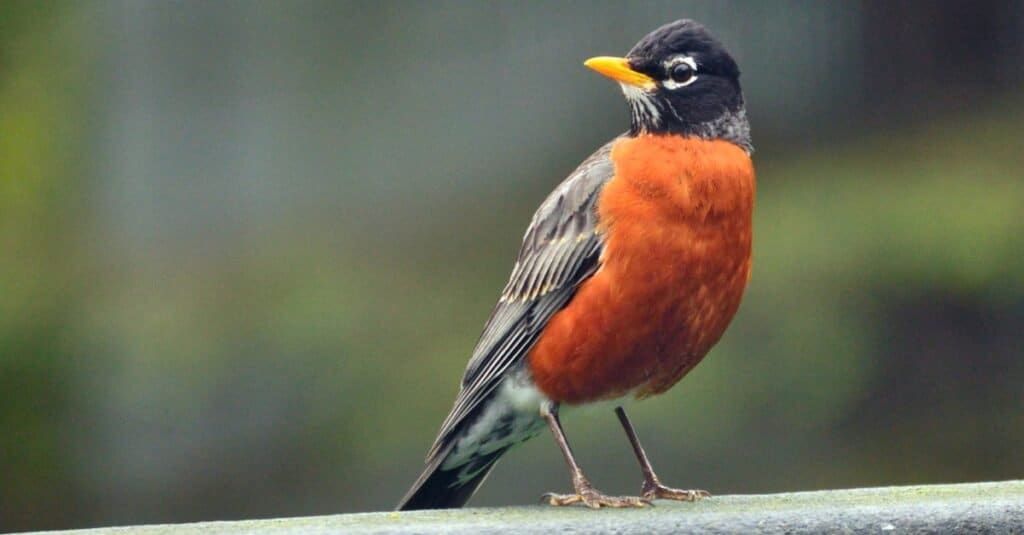
The American robin has a dark gray or brown back and wings, a reddish-orange breast, and belly. Its head is black with a white eye ring and a yellow bill.
©iStock.com/PhotosByMSA
Warblers
American Redstart
The American redstart (Setophaga ruticilla) is a small, migratory New World warbler that is found in North and South America. It is a small bird, measuring about 4.3-5 inches (11-12 cm) in length with a wingspan of around 7-8 inches (17-20 cm). It has a slim build with a thin, pointed bill and long wings and tail. The American redstart’s plumage is black and bright orange-yellow. The male has a black head, back, and wings, with bright orange-yellow patches on its sides, belly, and tail.
Females of the species are much paler than males and have orange-red tails and underparts. Their throats are fair, and they have brown-to-gray backs. American redstarts are found in a variety of habitats, including forests, woodlands, and shrubby areas. They breed in North America during the summer months and winter in Central and South America. American redstarts are active and nimble birds that are often seen flitting through the treetops as they forage for insects. They are known for their distinctive flash and flick foraging behavior, in which they fan their tails and wings to flush out insects. American redstarts also have a sweet, warbling song that is used to establish territories and attract mates.
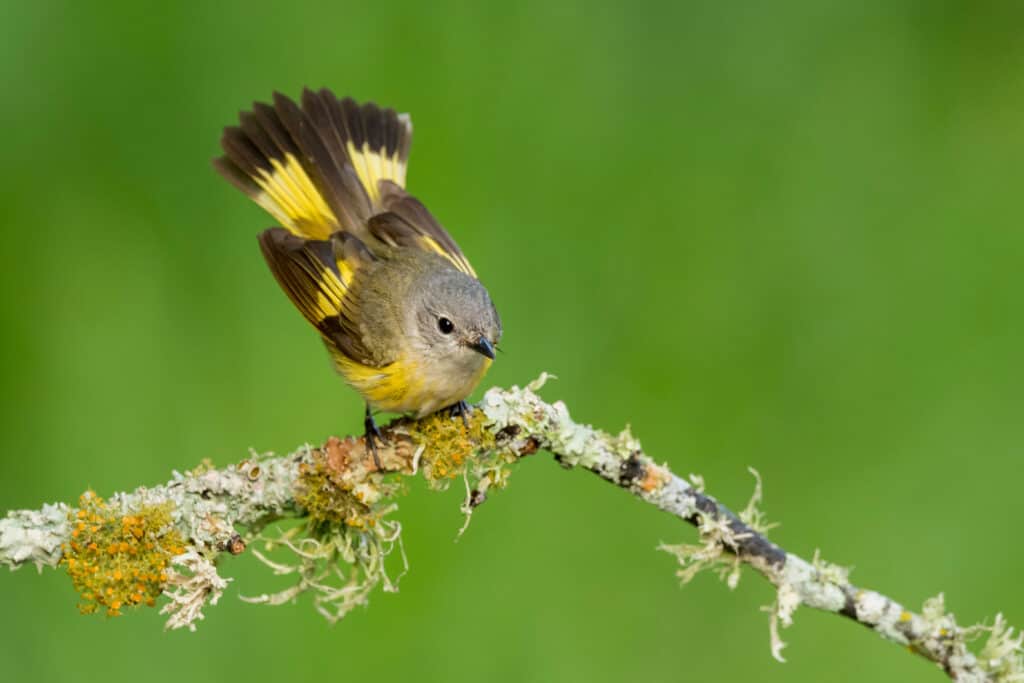
Female redstarts are much paler than males and have orange-red tails and underparts. Their throats are fair, and they have brown-to-gray backs.
©Agami Photo Agency/Shutterstock.com
Blackburnian Warbler
The Blackburnian warbler (Setophaga fusca) is a distinctive bird that is identified by its black and orange-yellow plumage, as well as its preference for mature coniferous and mixed forests. Its high-pitched song and active foraging behavior make it a popular species among birdwatchers. The Blackburnian warbler is a small bird, measuring about 4.5-5 inches (11-12 cm) in length with a wingspan of around 7.5 inches (18 cm). It has a slim build with a thin, pointed bill and long wings and tail.
The male Blackburnian warbler has a black back, a bright orange-yellow throat and breast, and white underparts. It also has a distinctive flame-orange patch on its head. The female is similar in appearance but has a duller overall coloration and less vibrant orange markings. Blackburnian warblers breed in mature coniferous and mixed forests in North America and spend their winters in Central and South America. Blackburnian warblers are active and graceful birds that are often seen flitting through the treetops as they forage for insects. They also have a distinctive high-pitched song that is used to establish territories and attract mates.
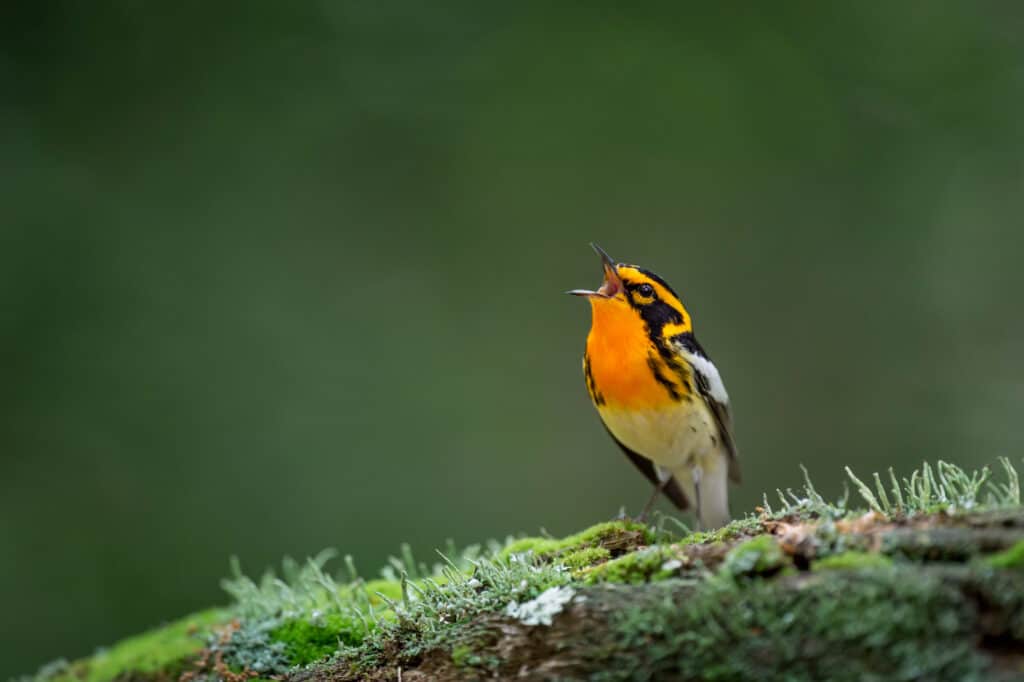
The Blackburnian warbler
(Setophaga fusca) is a striking and distinctive bird that is identified by its black and orange-yellow plumage
©Ray Hennessy/Shutterstock.com
Evening Grosbeak
The evening grosbeak (Coccothraustes vespertinus) is a colorful bird that is native to North America. It is a plump, stocky bird, measuring about 7-8 inches (17-20 cm) long with a wingspan of 12-14 inches (30-35 cm). It has a large head and a short, thick neck. The male evening grosbeak has a bright yellow head, back, and underparts. The wings and tail are black, with white patches on the wings.
The female evening grosbeak is more subdued in color, with a grayish-brown head, back, and wings, and yellowish underparts. Like the male, the female also has white patches on the wings. They are found in coniferous forests and woodlands, especially those with abundant seeds and fruits. Evening grosbeaks are social birds that often forage in small flocks. They have strong, conical bills that are adapted for cracking open hard seeds. They feed primarily on tree seeds, buds, and fruits.
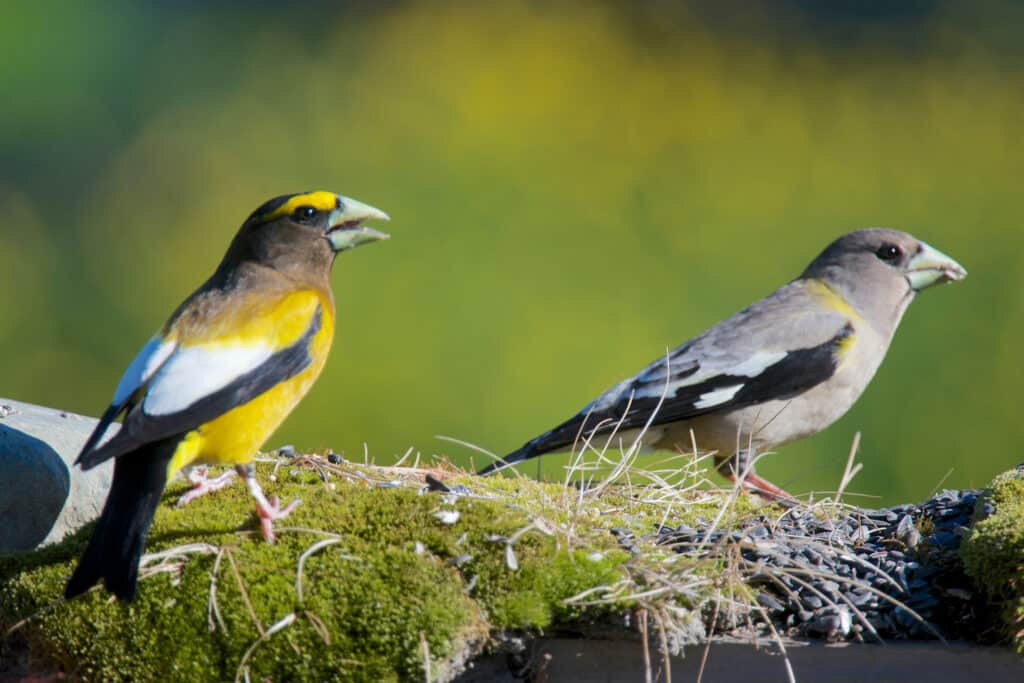
The male evening grosbeak has a bright yellow head, back, and underparts. The wings and tail are black, with white patches on the wings. The female evening grosbeak is more subdued.
©Danita Delimont/Shutterstock.com
Varied Thrush
The varied thrush is a handsome bird and is often a favorite among birdwatchers due to its unique appearance. It is rather large, between 20 to 26 cm 8-10.) inches(20-25 cm) in length with a wingspan of 13 to 17 inches (34 to 42 cm). Varied thrushes can be found in forests and woodlands, particularly in areas with dense understory vegetation and proximity to streams or other water sources. It is a medium-sized songbird that is found in the Pacific Northwest of North America.
The varied thrush has bold plumage that features a bright orange breast. The back of the bird is a deep blue-gray color, with black wings. The bill of the varied thrush is sharp and black. The female varied thrush is similar in appearance to the male, but she has a slightly duller plumage, with less vibrant orange on the breast.
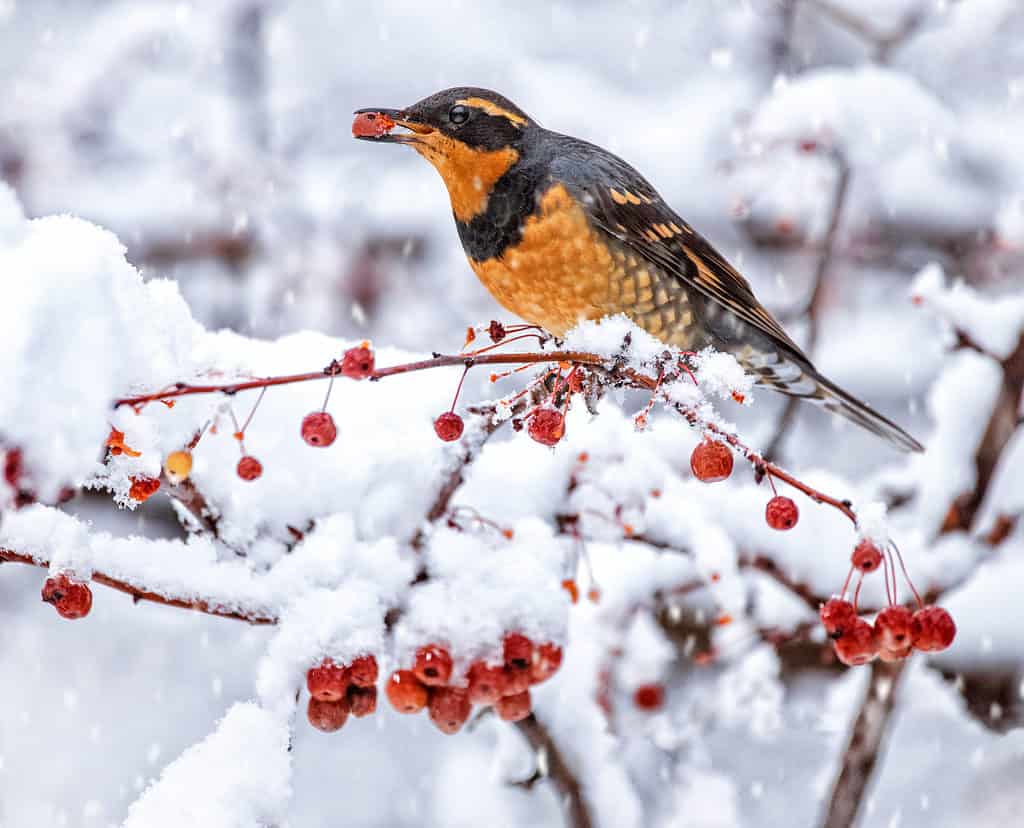
The varied thrush has bold plumage that features a bright orange breast.
©Annette Shaff/Shutterstock.com
Summary of 11 Birds That Look Like Orioles
| Bird | |
|---|---|
| 1 | Barn Swallow |
| 2 | Eastern Meadowlark |
| 3 | Western Meadowlark |
| 4 | Western Tanager |
| 5 | Eastern Towhee |
| 6 | Spotted Towhee |
| 7 | American Robin |
| 8 | American Redstart |
| 9 | Blackburnian Warbler |
| 10 | Evening Grosbeak |
| 11 | Varied Thrush |
The photo featured at the top of this post is © Luis Marquez/Shutterstock.com
Thank you for reading! Have some feedback for us? Contact the AZ Animals editorial team.






